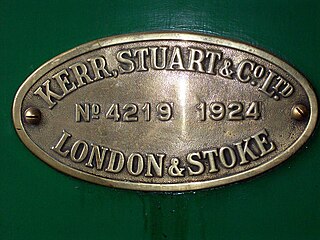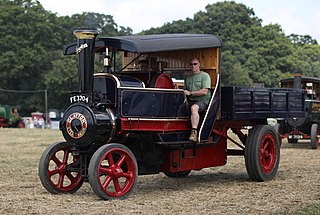
The Birmingham Railway Carriage and Wagon Company (BRC&W) was a railway locomotive and carriage builder, founded in Birmingham, England and, for most of its existence, located at nearby Smethwick, with the factory divided by the boundary between the two places. The company was established in 1854.
The War Department Light Railways were a system of narrow gauge trench railways run by the British War Department in World War I. Light railways made an important contribution to the Allied war effort in the First World War, and were used for the supply of ammunition and stores, the transport of troops and the evacuation of the wounded.

Sentinel Waggon Works Ltd was a British company based in Shrewsbury, Shropshire that made steam-powered lorries, railway locomotives, and later, diesel engined lorries, buses and locomotives.

Kerr, Stuart and Company Ltd was a locomotive manufacturer in Stoke-on-Trent, England.

W. G. Bagnall was a locomotive manufacturer from Stafford, England which was founded in 1875 and operated until it was taken over in 1962 by English Electric.

Alan Keef Ltd is a British narrow gauge railway engineering company which manufactures, overhauls, and deals in narrow gauge locomotives, rolling stock and associated equipment.

The NZR RM class McEwan Pratt petrol rail motor was the first rail motor to run on New Zealand's national rail network, though it was never used in revenue service. It was built in 1912 at a time when the New Zealand Railways Department (NZR) was seeking alternative methods of providing rural passenger transportation. "Mixed" trains that carried both passengers and freight were typical on country branch lines as there was not sufficient traffic to justify a separate passenger train, but the schedule delays caused by loading and unloading freight during the journey made the mixed trains undesirable.

The Baguley valve gear is a type of steam engine valve gear invented by Ernest E. Baguley, the Chief Draughtsman of the W.G. Bagnall company of locomotive manufacturers and patented in 1893. It was used by Bagnall during Baguley's time there, then by his own company of Baguley Cars Ltd.
The Drewry Car Co was a railway locomotive and railcar manufacturer and sales organisation from 1906 to 1984. At the start and the end of its life it built its own products, for the rest of the time it sold vehicles manufactured by sub-contractors. It was separate from the lorry-builder, Shelvoke & Drewry, but it is believed that James Sidney Drewry was involved with both companies.

Ernest E. Baguley (1863–1948) was a British engineer.
Baguley is an electoral ward of the city of Manchester in Wythenshawe, England.
Winson Engineering was a British manufacturer of narrow gauge and miniature railway steam locomotives and rolling stock during the 1990s. It built several new locomotives for heritage railways as well as undertaking major rebuilds of existing locomotives.

A & G Price Limited is an engineering firm and locomotive manufacturer in Thames, New Zealand founded in 1868.
The Ryknield Motor Company, originally established as the Ryknield Engine Company was a short-lived motor car manufacturer of the early twentieth century. Based in Burton-upon-Trent in England, the company was formed by a number of prominent business men in February 1902. Ernest E. Baguley, who had apprenticed in the rail industry with Hawthorn Leslie and Company, and then W. G. Bagnall, saw the potential of the motor car, and in 1901, Baguley designed a steam-engine for a motor car. His employer at the time, Bagnalls, were not interested in the concept, so he left the company and joined the Ryknield Engine Company as manager in November 1902.
Francis Claude Blake was a British engineer, known for his pioneering work designing and manufacturing cars, boats and railway locomotives. He was a member of the Institution of Automobile Engineers.

Clayton Wagons Ltd. of Lincoln were formed as a subsidiary company of Clayton & Shuttleworth in 1920. The company occupied the Abbey Works, Titanic Works and Clayton Forge. The company produced drop forgings, Steam Wagons, Electric Vehicles, Railway Carriages and Rolling stock. The main company, Clayton Shuttleworth, which was producing agricultural machinery, continued to operate from the Stamp End Works. Both companies found it very difficult to adapt to the post war economic situation and by 1923 Clayton and Shuttleworth's Eastern European trade had shrunk to 6% of its pre-War level. The firms struggled during the Great Depression and ceased trading on 18 February 1930. The Clayton Wagons premises came to be occupied by Clayton-Dewandre Ltd. and Smith-Clayton Forge Ltd.

Baguley 774 is one of the earliest surviving narrow-gauge internal combustion locomotives. It was built in 1919 for the Timber Supply Department of the Board of Trade. After a varied career, it was preserved at the Narrow Gauge Railway Museum in Tywyn.

McEwan Pratt was a manufacturer of narrow-gauge internal combustion locomotives, founded around 1905 in Wickford, Essex. It produced a wide variety of locomotives and railcars, but failed as a business and became a subsidiary of Baguley Cars Ltd in 1912.
Kent Construction and Engineering Co., Ltd., of Victoria Works, Victoria Road, Ashford, Kent are best known for purchasing many former World War I War Department Light Railways locomotives at the end of the war, both narrow and standard gauge, and reselling them after repair and reconditioning using the "Planet" trademark. It went on to design its own locomotives, and one of the new designs was shown at the Public Works, Roads & Transport Exhibition at Islington in November, 1925, by Honeywill Brothers.

















